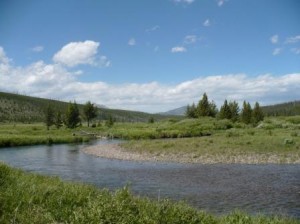
Obsidian Creek
For years I pretty much avoided waters demanding lightweight equipment, but when I experienced the fun of using such, I succumbed to what Ernie Schwiebert named “The Song of the Small Stream.” Now I make it a point to fish small waters, especially ones new to me, and Yellowstone Park offers numerous candidates to enjoy.
When we think of fly-fishing Yellowstone Park, streams with the great names always come to mind. Such as the Bechler, Fall, Firehole, Gallatin, Gibbon, Madison, Slough, Yellowstone deserve all the renown they are given. But these are only “the tip of the iceberg” when it comes to the quality streams that the Park offers the visiting fly-fisher. The number of quality small waters here is almost overwhelming, but we can start here by describing some of the most approachable and best. To do this let’s first concentrate on those around the Grand Loop with words about location and strategy. For all of these small waters lightweight equipment is most appropriate. When one heads north out of Norris Junction the fun begins. The Gibbon River, especially around Norris Junction and its tributary Solfatara Creek offer brook, brown and rainbow trout with a very occasional grayling in the river. These eager fish take almost any offering, especially dry attractor and terrestrial and small beadhead nymph patterns. These streams do get “hammered” a bit because of the large campground at the Junction, but evening visits will offer some solitude. Further north on the Grand Loop heading to Mammoth, an number of small roadside streams are present. Obsidian and Indian Creeks and the upper Gardner River offer almost non-stop action for brookies that will take anything they can get their mouth around. When one pasts Mammoth heading east, Lava Creek offers browns and rainbows and Blacktail Deer Creek offers brookies, but all these are not quite as eager as the Obsidian and Indian Creek brookies. Fast water attractor, caddis, terrestrial and small bead head nymph patterns will work well as they will for Tower Creek rainbows further east at Tower Junction. After one turns south, descends Mount Washburn, and approaches the Canyon area, a short walk takes one from a picnic area to Cascade Creek and its Yellowstone cutthroat trout. This is a meadow stream, so any kind of hopper, ant or beetle pattern will bring the cutts to the surface. Not many small waters are available further south along the Grand Loop. But after one turns west from Thumb Junction and travels toward Old Faithful, DeLacey Creek crosses the highway near the halfway point. Brook Trout inhabit this creek, and if the adventurous fly-fisher walks down the creek about a mile on the well maintained trail, the stream passes through a meadow that offers terrestrial insects to its eager brookie population. After passing Old Faithful heading down the Firehole River one approaches Upper Geyser Basin, and Iron Spring Creek and Little Firehole River enter from the west. The lower parts of these streams act as a summertime refuge for Firehole River trout with their cooler waters. because of their increased summertime trout population, these streams attract fly-fishers. Further downstream as one approaches the Firehole River Canyon, Nez Perce Creek crosses the highway. If one parks in the nearby campground and walks upstream away from the highway, good fishing for brook, brown, and rainbow trout can be had.
So here’s a look at some of the best small stream candidates around the Grand Loop, the most visited part of the Park. Rest assured that roads from the five entrances feeding the Grand Loop pass by quality small streams. Perhaps an article describing some of these waters would be fitting. One thing for sure; you will find a better measure of solitude on all these streams.

